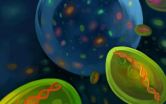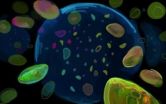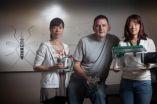(Press-News.org) The smallest, most abundant marine microbe, Prochlorococcus, is a photosynthetic bacterial species essential to the marine ecosystem.
It's estimated that billions of the single-celled creatures live in the oceans, forming the center of the marine food web.
They occupy a range of ecological niches based on temperature, light, water chemistry and interactions with other species.
But the diversity within this single species remains a puzzle.
To probe this question, scientists at the Massachusetts Institute of Technology (MIT) recently performed a cell-by-cell genomic analysis of a wild population of Prochlorococcus living in a milliliter of ocean water--less than a quarter of a teaspoon--and found hundreds of distinct genetic subpopulations.
Each subpopulation in those few drops of water is characterized by a set of core gene alleles linked to a few associated flexible genes--a combination the scientists call the "genomic backbone."
This backbone gives the subpopulation a finely tuned ability to fill a particular ecological niche.
Diversity also exists within backbone subpopulations; most individual cells in the samples carried at least one set of flexible genes not found in any other cell in its subpopulation.
A report on the research by Sallie Chisholm and Nadav Kashtan at MIT, along with co-authors, appears in this week's issue of the journal Science.
The National Science Foundation (NSF), through its Divisions of Environmental Biology and Ocean Sciences, supported the research.
"In this extraordinary finding on the power of natural selection, the scientists have discovered a mosaic of genetically distinct populations of one of the most abundant organisms on Earth," says George Gilchrist, program director in NSF's Division of Environmental Biology.
"In spite of the constant mixing of the oceans," Gilchrist says, "variations in light, temperature and chemistry create unique habitats that evolution has filled with an enormous diversity of populations over millions of years."
Adds David Garrison, program director in NSF's Division of Ocean Sciences, "The results will change the way marine ecologists think about how planktonic microbes and, in turn, planktonic communities may respond to climate and environmental change."
The scientists estimate that the subpopulations diverged at least a few million years ago.
The backbone is an older, more slowly evolving, component of the genome, while the flexible genes reside in areas of the genome where gene exchange is relatively frequent, facilitating more rapid evolution.
The study also revealed that the relative abundance of the backbone subpopulations changes with the seasons at the study site near Bermuda, adding strength to the argument that each subpopulation is finely tuned for optimal growth under different conditions.
"The sheer enormity of diversity that must be in the octillion Prochlorococcus cells living in the seas is daunting to consider," Chisholm says. "It creates a robust and stable population in the face of environmental instability."
Ocean turbulence also plays a role in the evolution and diversity of Prochlorococcus.
A fluid mechanics model predicts that in typical ocean flow, just-divided daughter cells drift rapidly, placing them centimeters apart from one another in minutes, tens of meters apart in an hour, and kilometers apart in a week's time.
"The interesting question is, 'Why does such a diverse set of subpopulations exist?'" Kashtan says.
"The huge population size of Prochlorococcus suggests that this remarkable diversity and the way it is organized is not random, but is a masterpiece product of natural selection."
Chisholm and Kashtan say the evolutionary and ecological distinction among the subpopulations is probably common in other wild, free-living (not attached to particles or other organisms) bacteria species with large populations and highly mixed habitats.
INFORMATION:
Other co-authors of the paper are Sara Roggensack, Sébastien Rodrigue, Jessie Thompson, Steven Biller, Allison Coe, Huiming Ding, Roman Stocker and Michael Follows of MIT; Pekka Marttinen of the Helsinki Institute for Information Technology; Rex Malmstrom of the U.S. Department of Energy Joint Genome Institute and Ramunas Stepanauskas of the Bigelow Laboratory for Ocean Sciences.
The NSF Center for Microbial Oceanography, U.S. Department of Energy Genomics Science Program and the Gordon and Betty Moore Foundation Marine Microbiology Initiative also supported the work.
Octillions of microbes in the seas: Ocean microbes show incredible genetic diversity
In a few drops of seawater, 1 species, hundreds of subpopulations
2014-04-29
ELSE PRESS RELEASES FROM THIS DATE:
Consuming high-protein breakfasts helps women maintain glucose control, MU study finds
2014-04-29
COLUMBIA, Mo. – In healthy individuals, the amount of glucose, or sugar, in the blood increases after eating. When glucose increases, levels of insulin increase to carry the glucose to the rest of the body. Previous research has shown that extreme increases in glucose and insulin in the blood can lead to poor glucose control and increase an individual's risk of developing diabetes over time. Now, a University of Missouri researcher has found that when women consumed high-protein breakfasts, they maintained better glucose and insulin control than they did with lower-protein ...
New data suggest potassium & dietary fiber intake among toddlers should be priority
2014-04-29
(SAN DIEGO, CA) April 29, 2014 – Recommendations to increase the intake of potassium and dietary fiber among young children should be a priority for the 2020 Dietary Guidelines for Americans, according to a new study by the Alliance for Potato Research and Education (APRE) presented today at Experimental Biology 2014.
While the federal Dietary Guidelines has focused on adults and children 2 years of age and older, the 2020 Dietary Guidelines will include Americans of all ages, starting from birth, noted Maureen Storey, PhD, co-author of the study and APRE president and ...
Two-part special issue of Ergonomics in Design highlights climate change
2014-04-29
Human factors/ergonomics (HF/E) experts, like professionals in many other scientific domains, have joined the fight against global warming and climate change. Their research and practice focus on finding ways to combat or minimize its serious effects.
A special two-part issue of Ergonomics in Design examines how HF/E professionals can continue working to mitigate this worldwide phenomenon. Part 1 of the special issue, guest edited by Ken Nemire, is now available online and may be found at http://erg.sagepub.com/.
"With recent research indicating we stay close to ...
NRL researchers develop harder ceramic for armor windows
2014-04-29
The Department of Defense needs materials for armor windows that provide essential protection for both personnel and equipment while still having a high degree of transparency. To meet that need, scientists at the Naval Research Laboratory (NRL) have developed a method to fabricate nanocrystalline spinel that is 50% harder than the current spinel armor materials used in military vehicles. With the highest reported hardness for spinel, NRL's nanocrystalline spinel demonstrates that the hardness of transparent ceramics can be increased simply by reducing the grain size to ...
Saving crops and people with bug sensors
2014-04-29
RIVERSIDE, Calif. (http://www.ucr.edu) — University of California, Riverside researchers have created a method that can classify different species of insects with up to 99 percent accuracy, a development that could help farmers protect their crops from insect damage and limit the spread of insect-borne diseases, such as malaria and Dengue fever.
Over the past 60 years, insect classification research has been limited by factors including an overreliance on acoustic sensing devices, a heavy focus on wingbeat frequency and limited data.
The UC Riverside researchers overcame ...
The Strangler: The chemistry behind the Game of Thrones poison (video)
2014-04-29
WASHINGTON, April 28, 2014 — Game of Thrones gave us a shock with the Purple Wedding and now everyone is asking: "Who poisoned King Joffrey?" While the search for the killer continues, the American Chemical Society's latest Reactions video focuses on what killed the hated king. The video is available at http://youtu.be/6UNEpRXcxM4
Chemist Raychelle Burks, Ph.D., of Doane College helps us narrow down the suspects in her charismatic style, blending pop culture and chemistry. "Sometimes science gets a bad rap. People think it's dry or super serious," Burks says. "Pop culture ...
Information technology can simplify weight-loss efforts; social support still important for success
2014-04-29
COLUMBIA, Mo. – According to the Centers for Disease Control and Prevention (CDC), 69 percent of adults in the United States are currently overweight or obese, which puts these individuals at increased risk for chronic health problems. Although weight loss decreases this risk, statistics show that dieters often fail multiple times before meeting their goals. Now, MU researchers have found that information technology, such as smartphone applications, can help dieters integrate healthy behavior changes into their daily lives.
"Current weight loss recommendations are essentially ...
Immunogenic mutations in tumor genomes correlate with increased patient survival
2014-04-29
April 29, 2014 – Developing immunotherapies for cancer is challenging because of significant variability among tumors and diversity in human immune types. In a study published online today in Genome Research, researchers examined the largest collection of tumor samples to date to predict patient-specific tumor mutations that may activate the patient's immune system, paving the way for more successful, personalized cancer immunotherapy.
Tumor cells accrue mutations in their DNA, and as these mutations accumulate, the cell looks less and less like part of the body and more ...
Vitamin D may raise survival rates among cancer patients
2014-04-29
Washington, DC—Cancer patients who have higher levels of vitamin D when they are diagnosed tend to have better survival rates and remain in remission longer than patients who are vitamin D-deficient, according to a new study published in the Endocrine Society's Journal of Clinical Endocrinology & Metabolism (JCEM).
The body naturally produces vitamin D after exposure to sunlight and absorbs it from certain foods. In addition to helping the body absorb the calcium and phosphorus needed for healthy bones, vitamin D affects a variety of biological processes by binding to ...
Study: WHO tool underestimates need for osteoporosis treatment
2014-04-29
Washington, DC—The World Health Organization's tool for assessing bone fracture risk underestimates the true dangers for people who are younger than 65 or have been treated for a single broken bone, according to a new study published in the Endocrine Society's Journal of Clinical Endocrinology & Metabolism (JCEM).
A WHO task force developed the Fracture Risk Assessment Tool (FRAX) to help predict the likelihood of adults between the ages of 40 and 90 breaking a bone. FRAX is designed to evaluate the chances that a person will break a bone in a minor fall, which is called ...
LAST 30 PRESS RELEASES:
The impact of family dynamics on eating behaviour – how going home for Christmas can change how you eat
Tracing the quick synthesis of an industrially important catalyst
New software sheds light on cancer’s hidden genetic networks
UT Health San Antonio awarded $3 million in CPRIT grants to bolster cancer research and prevention efforts in South Texas
Third symposium spotlights global challenge of new contaminants in China’s fight against pollution
From straw to soil harmony: International team reveals how biochar supercharges carbon-smart farming
Myeloma: How AI is redrawing the map of cancer care
Manhattan E. Charurat, Ph.D., MHS invested as the Homer and Martha Gudelsky Distinguished Professor in Medicine at the University of Maryland School of Medicine
Insilico Medicine’s Pharma.AI Q4 Winter Launch Recap: Revolutionizing drug discovery with cutting-edge AI innovations, accelerating the path to pharmaceutical superintelligence
Nanoplastics have diet-dependent impacts on digestive system health
Brain neuron death occurs throughout life and increases with age, a natural human protein drug may halt neuron death in Alzheimer’s disease
SPIE and CLP announce the recipients of the 2025 Advanced Photonics Young Innovator Award
Lessons from the Caldor Fire’s Christmas Valley ‘Miracle’
Ant societies rose by trading individual protection for collective power
Research reveals how ancient viral DNA shapes early embryonic development
A molecular gatekeeper that controls protein synthesis
New ‘cloaking device’ concept to shield sensitive tech from magnetic fields
Researchers show impact of mountain building and climate change on alpine biodiversity
Study models the transition from Neanderthals to modern humans in Europe
University of Phoenix College of Doctoral Studies releases white paper on AI-driven skilling to reduce burnout and restore worker autonomy
AIs fail at the game of visual “telephone”
The levers for a sustainable food system
Potential changes in US homelessness by ending federal support for housing first programs
Vulnerability of large language models to prompt injection when providing medical advice
Researchers develop new system for high-energy-density, long-life, multi-electron transfer bromine-based flow batteries
Ending federal support for housing first programs could increase U.S. homelessness by 5% in one year, new JAMA study finds
New research uncovers molecular ‘safety switch’ shielding cancers from immune attack
Bacteria resisting viral infection can still sink carbon to ocean floor
Younger biological age may increase depression risk in older women during COVID-19
Bharat Innovates 2026 National Basecamp Showcases India’s Most Promising Deep-Tech Ventures
[Press-News.org] Octillions of microbes in the seas: Ocean microbes show incredible genetic diversityIn a few drops of seawater, 1 species, hundreds of subpopulations





